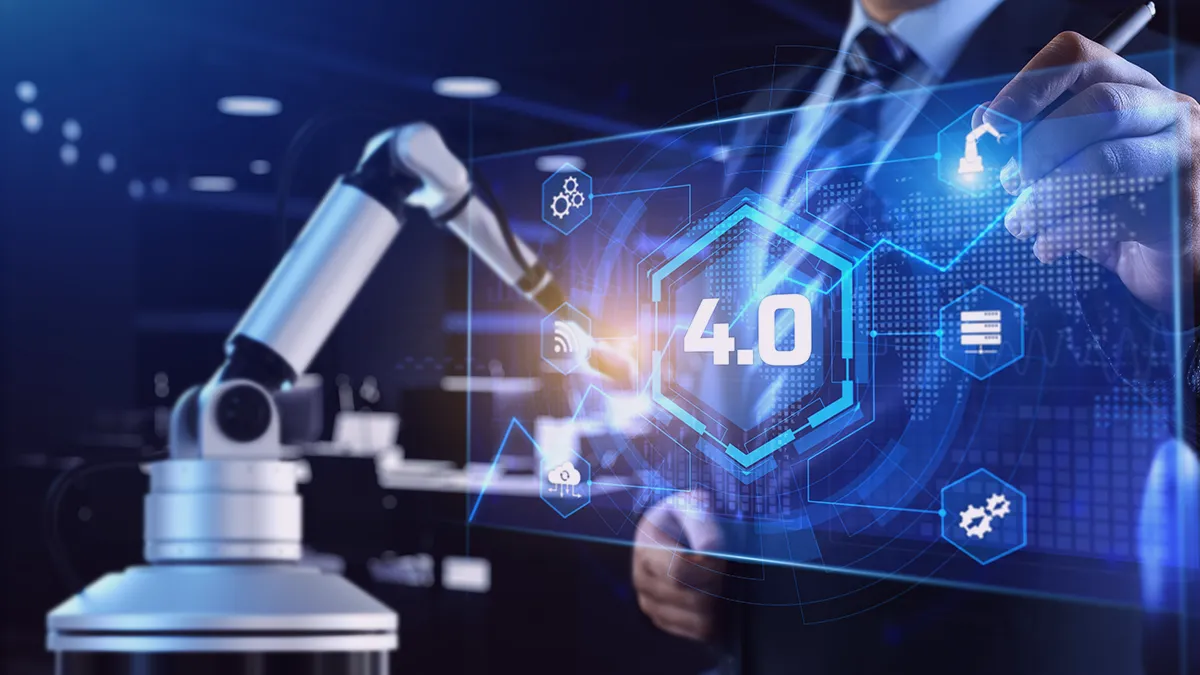Industry 4.0 in the context of manufacturing companies

What is the fourth industrial revolution ?
Industry 4.0, also referred to as the fourth industrial revolution, is a concept encompassing a complex process of technological and organizational transformation of companies, which began in 2013. Combining modern technologies with traditional production processes, it involves the integration of the value chain, the introduction of new business models, and the digitization of products and services.
Seven Stages of Transformation in the Fourth Industrial Revolution
Industry 4.0. according to the European Center for the Advancement of Advanced Manufacturing includes seven stages:
- The first stage – refers to the implementation of advanced technologies and flexible production systems that enable rapid adaptation to changes in production.
- The second stage – data management and exchange of information about the production process between people, machines and products.
- The third stage – focuses on the principles of a circular economy to maximize the use of raw materials and reduce emissions.
- The fourth stage, End-to-End Customer Focused Engineering, focuses on comprehensively meeting customer expectations.
- The fifth stage emphasizes the importance and role of people, using individual differences to strengthen the organization and create a suitable work environment.
- The sixth stage, smart manufacturing and industrial automation, involves the use of integrated systems that respond in real time to changing conditions, and the use of big data, AI and machine learning solutions.
- The last, seventh stage, is the smart factory, the open factory where there is an understanding of the needs of all participants in the value chain within the company.

Industry 4.0 for manufacturing companies – opportunity or challenge?
The introduction of Industry 4.0 for manufacturing companies means a profound transformation is required. While all four industrial revolutions have had massive impacts, the current revolution is unfolding at an unprecedented rate, requiring efficient change management, digitization of industrial plants and their automation.
Companies are investing in new technologies, modernizing production lines and developing employee competencies. Integration of IT systems with OT (Operational Technology) is becoming crucial, enabling full automation and remote management of production processes. The result is increased productivity, reduced operating costs, better product quality and quicker response to changing market needs.
Biggest challenges
One of the biggest challenges for companies in the context of Industry 4.0 is the high initial cost of investing in new technologies. Companies should be ready to purchase modern machinery, IT systems and train employees. However, automation of industrial production is not only about artificial intelligence and smart factories. Cybersecurity is another challenge, as increased connectivity and integration of systems creates new vulnerabilities and risks. Additionally, managing large amounts of data (big data) requires the right tools for analysis and interpretation, which is essential for making effective decisions.
Opportunities for companies
Industry 4.0 opens up huge opportunities for manufacturing companies. The global market for Industry 4.0. is rushing and, in the end, will not spare companies that have remained resistant to implementing the technology, thus delaying their entry into the new era of manufacturing. Integration of Industry 4.0 is inevitable for companies that want to remain competitive in a rapidly changing manufacturing environment. By using modern technologies, they can offer higher quality products at lower production costs. Automated and intelligent processes allow personalization of products, which is becoming increasingly important in the era of individual customer needs. In addition, with better data analysis, companies optimize processes, minimize waste and predict failures, leading to significant savings and increased production reliability.
Implementing the concept of Industry 4.0 is a transformation involving many different aspects, requiring very good preparation, learning new tools and dynamically adapting them to the changing needs of the company. It is therefore necessary to take a strategic approach and remain flexible. Otherwise, the potential of modern technologies will not be fully exploited.
How to start the digital transformation of an enterprise?
Embarking on a company’s digital transformation is a process that requires strategic planning and appropriate investment. If you want to bring automation to industrial production, the first step is to understand the current technological state of the company and identify areas that could benefit from new technologies. Next, it’s worth creating a transformation plan that takes into account business goals, needed resources and a timeline for implementation. It is crucial to involve management and employees at all levels to ensure a smooth transition to new technologies. Investment in training and development of employees’ digital competencies is essential to maximize the potential of modern tools.
You can read more about it in the article: How to implement the assumptions of Industry 4.0 in a company?
Smart Industry – what to invest in first?
Industrial Internet of Things
The Industrial Internet of Things (IIoT) is the foundation of Industry 4.0, enabling machines, equipment and systems to be networked together. Investing in IIoT allows production processes to be monitored in real time, increasing efficiency and reducing downtime. IIoT sensors and devices collect data from various points in production, providing valuable information for further analysis.
Big Data and Data Analytics
Collecting and analyzing big data is another important part of the Smart Industry. Investing in big data analysis tools allows companies to better understand their production processes, identify bottlenecks and predict future trends. Data analysis also enables better decision-making, leading to increased productivity and product quality.
Artificial Intelligence (AI) and Machine Learning (ML).
AI and machine learning are playing a key role in optimizing manufacturing processes. Artificial intelligence allows automation of tasks that previously required human intervention, such as quality control and failure prediction. Industrial automation through AI algorithms can analyze IIoT sensor data and predict potential problems before they occur, allowing for proactive production management.
Cyber-Physical Systems (CPS)
Cyber-physical systems (CPS) integrate digital technologies with physical processes, enabling more precise and flexible production management. Investment in CPS allows for the creation of smart factories, where machines communicate with each other and make autonomous decisions. CPS increases production flexibility, enabling rapid adaptation to changing market needs.
Industrial automation and robotics
Automation and robotics are the foundations of modern production lines. Investment in advanced industrial robots allows complex and precise tasks that are difficult for humans to achieve. Automation of production processes increases efficiency, reduces costs and minimizes the risk of errors.
Digitization of industrial plants (implementation of Industry 4.0) is a complex process that requires a strategic approach and appropriate investments. Companies that want to be competitive in today’s market need to focus on key technologies, such as the Industrial Internet of Things IIoT, big data, AI, CPS and automation, in order to realize the full potential of modern technology.
Production monitoring and OEE as the first step to Smart Factory
Monitoring production and Overall Equipment Effectiveness (OEE) is a fundamental step toward implementing Industry 4.0. OEE allows for accurate tracking of productivity, availability and quality of production processes, which is key to identifying areas for optimization. By monitoring production in real time, companies can quickly respond to issues, minimize downtime and maximize operational efficiency. The introduction of data monitoring and analysis systems therefore becomes an essential first step in a company’s digital transformation.
Read more in the article: https://ttpsc.com/en/blog/oee-is-your-company-stuck-in-a-manipulation-trap/
Industry 4.0 is a concept that may initially frighten even companies that have already taken a step toward digital transformation. However, there is no doubt that the increasing awareness, availability of tools and specialists in the market means that the technological revolution can be carried out efficiently, quickly, and effectively. Check out our offer and contact us – let’s talk about your company’s needs.
